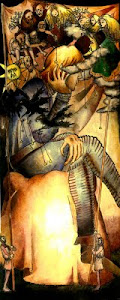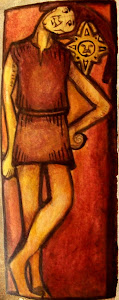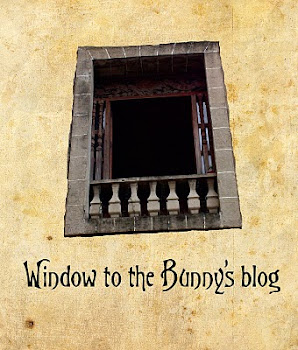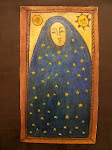My Anthropology professor said that humans don't like reality, especially in their art. So they tend to exaggerate real proportions, distorting figures in desired areas, and they probably interpreted real as something like that. Well, I know it is still open for an open debate, but for me I interpreted grotesque as something more than just real, and they are not just mirrors of the real but something to discover with.
I've seen so many artists that they rely their works on grotesque. One of my favorite is the ones who are not much recognized; the artists of Gothic cathedrals.


Perhaps I spent a couple of minutes just staring at the pictures of gargoyles in a book in our library, thinking how did they manage to establish such beautiful and mysterious works. Although they are largely influenced by secular matters, they had freedom to unleash their imagination that is almost incomparable today. I heard a legend about a sculptor of gargoyles in Notre Dame who set the faces of his works from his appearance. His works are filled with sorrow, and so as the artist because he was left by his beloved girl. Somehow, these grotesque creatures portrayed from their infinite imagination, where for them there was a thin boundary between real and unreal. And I salute them for their immeasurable imagination and strangeness.

I also saw from a book in our library about Pieter Bruegel. They had a picture of Bosch's illustration of quite strange creatures
 The book also had a picture of a flying buttress in the cathedral of St. John in Flanders. They are quite interesting to observe.
The book also had a picture of a flying buttress in the cathedral of St. John in Flanders. They are quite interesting to observe.

Picasso's blue period is my favorite works of him. It just reminds me of El Greco's Burial of Count Oegaz. He portrayed decay-like skins, thin, almost androgynous people.
Since I illustrated my works inspired by medieval art, I illustrated this picture of my youngest sister, cracking her fingers while laughing exaggeratedly.

Done in watercolor on board, this is one of my little works last summer, before the this semester started. Although this is not her actual portrait, most of the features are based from her. From her tangled hair to her bony arms and legs.
I've seen so many artists that they rely their works on grotesque. One of my favorite is the ones who are not much recognized; the artists of Gothic cathedrals.


Perhaps I spent a couple of minutes just staring at the pictures of gargoyles in a book in our library, thinking how did they manage to establish such beautiful and mysterious works. Although they are largely influenced by secular matters, they had freedom to unleash their imagination that is almost incomparable today. I heard a legend about a sculptor of gargoyles in Notre Dame who set the faces of his works from his appearance. His works are filled with sorrow, and so as the artist because he was left by his beloved girl. Somehow, these grotesque creatures portrayed from their infinite imagination, where for them there was a thin boundary between real and unreal. And I salute them for their immeasurable imagination and strangeness.

I also saw from a book in our library about Pieter Bruegel. They had a picture of Bosch's illustration of quite strange creatures
 The book also had a picture of a flying buttress in the cathedral of St. John in Flanders. They are quite interesting to observe.
The book also had a picture of a flying buttress in the cathedral of St. John in Flanders. They are quite interesting to observe.
Since I illustrated my works inspired by medieval art, I illustrated this picture of my youngest sister, cracking her fingers while laughing exaggeratedly.






























